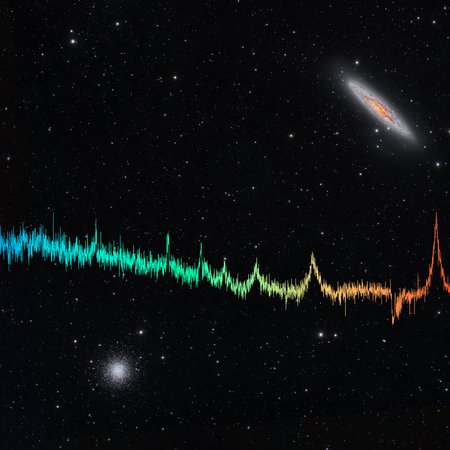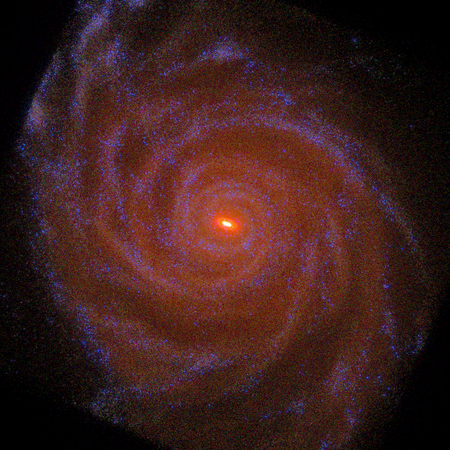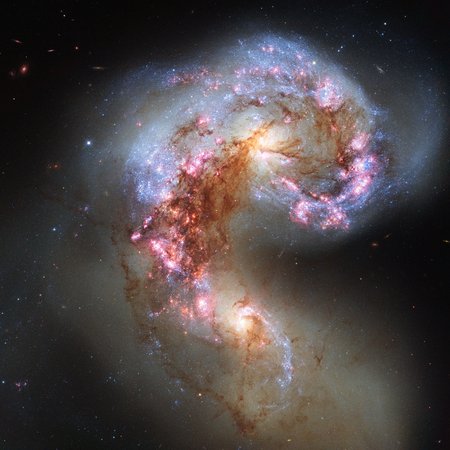Astronomers unveil secrets of giant elliptical galaxies
Davor Krajnović, astronomer at the Leibniz Institute for Astrophysics Potsdam (AIP), and his colleagues Eric Emsellem (ESO) and Marc Sarzi (University of Hertfordshire), have discovered how giant elliptical galaxies move. Their study is based on data obtained by the newly installed Multi Unit Spectroscopic Explorer (MUSE).
The three astronomers observed the giant galaxy M87 (NGC4486), which is the central galaxy in the Virgo cluster, and discovered that it displays some bulk rotation, albeit of a very low amplitude. The precision of MUSE allowed the team to reveal that the stars of M87 can move around its centre with average velocities of just 10-20 km/s. Equivalent to 36-72,000 km/h, this speed may seem very high, but for galaxies this is extremely slow.
Elliptical galaxies have long been considered as essentially being made up of old stars that move randomly within them, like a swarm of bees. This has been challenged in many instances in the past ten-twenty years, but giant elliptical galaxies are still considered as a nearly round and non-rotating group of old stars.
By showing that a "simple" galaxy like M87 can be quite complicated in the eyes of the new MUSE spectrograph, this result demonstrates the potential of this new instrument for further advancing our understanding of galaxies, and their formation. Davor Krajnović states: “MUSE has the capability to enhance our understanding of galaxies, how they form and develop. By using the MUSE velocity data to constrain simulation models, we might reach a whole new level of precision.” Their work is published in the Monthly Notices of the Royal Astronomical Society and a pre-publication version of the paper is available on arXiv: http://arxiv.org/abs/1408.6844.
The Multi Unit Spectroscopic Explorer (MUSE) is a 3D-spectrograph for the Very Large Telescope (VLT) of the European Southern Observatory at Paranal (Chile). MUSE features a complex optical system with the capacity to split and slice a field that measures one square arcminute on the sky into 90,000 spatial elements. For each point a spectrum is created, covering the optical and near infrared wavelength region of 465-930nm. AIP provides the Data Reduction Software and operates one of the data centres accessible to scientists from all over the world.

Left: Image of M87: Some small companion galaxies of this giant and round elliptical galaxy are visible to the right of the image. The red square delineates the field-of-view of the MUSE instrument, where the velocity of the central stars of M87 have been measured.
Right: A map for the average velocity of the stars in the central region of M87, divided in polygonal regions where the MUSE data have been combined to reach a sufficient quality for these measurements. After accounting that M87 as a whole is moving away from us, red or yellow bins show stars that on average are receding whereas blue or light azure bins show stars that on average are approaching. The MUSE map reveal a complex motion of the stars in M87, where stars move in one way in the central region and in another in its outskirts.
Credit: Adam Block, Mt Lemmon SkyCenter, U. ArizonaFurther information:
- Muse Website
- Press release “First Light for MUSE”, 5 March 2014
- Press release, University of Hertfordshire [not available anymore]
Science contact: Dr. Davor Krajnović, +49 331-7499 237, dkrajnovic@aip.de
Media contact: Kerstin Mork , +49 331-7499 469, presse@aip.de
Davor Krajnović, astronomer at the Leibniz Institute for Astrophysics Potsdam (AIP), and his colleagues Eric Emsellem (ESO) and Marc Sarzi (University of Hertfordshire), have discovered how giant elliptical galaxies move. Their study is based on data obtained by the newly installed Multi Unit Spectroscopic Explorer (MUSE).
The three astronomers observed the giant galaxy M87 (NGC4486), which is the central galaxy in the Virgo cluster, and discovered that it displays some bulk rotation, albeit of a very low amplitude. The precision of MUSE allowed the team to reveal that the stars of M87 can move around its centre with average velocities of just 10-20 km/s. Equivalent to 36-72,000 km/h, this speed may seem very high, but for galaxies this is extremely slow.
Elliptical galaxies have long been considered as essentially being made up of old stars that move randomly within them, like a swarm of bees. This has been challenged in many instances in the past ten-twenty years, but giant elliptical galaxies are still considered as a nearly round and non-rotating group of old stars.
By showing that a "simple" galaxy like M87 can be quite complicated in the eyes of the new MUSE spectrograph, this result demonstrates the potential of this new instrument for further advancing our understanding of galaxies, and their formation. Davor Krajnović states: “MUSE has the capability to enhance our understanding of galaxies, how they form and develop. By using the MUSE velocity data to constrain simulation models, we might reach a whole new level of precision.” Their work is published in the Monthly Notices of the Royal Astronomical Society and a pre-publication version of the paper is available on arXiv: http://arxiv.org/abs/1408.6844.
The Multi Unit Spectroscopic Explorer (MUSE) is a 3D-spectrograph for the Very Large Telescope (VLT) of the European Southern Observatory at Paranal (Chile). MUSE features a complex optical system with the capacity to split and slice a field that measures one square arcminute on the sky into 90,000 spatial elements. For each point a spectrum is created, covering the optical and near infrared wavelength region of 465-930nm. AIP provides the Data Reduction Software and operates one of the data centres accessible to scientists from all over the world.

Left: Image of M87: Some small companion galaxies of this giant and round elliptical galaxy are visible to the right of the image. The red square delineates the field-of-view of the MUSE instrument, where the velocity of the central stars of M87 have been measured.
Right: A map for the average velocity of the stars in the central region of M87, divided in polygonal regions where the MUSE data have been combined to reach a sufficient quality for these measurements. After accounting that M87 as a whole is moving away from us, red or yellow bins show stars that on average are receding whereas blue or light azure bins show stars that on average are approaching. The MUSE map reveal a complex motion of the stars in M87, where stars move in one way in the central region and in another in its outskirts.
Credit: Adam Block, Mt Lemmon SkyCenter, U. ArizonaFurther information:
- Muse Website
- Press release “First Light for MUSE”, 5 March 2014
- Press release, University of Hertfordshire [not available anymore]
Science contact: Dr. Davor Krajnović, +49 331-7499 237, dkrajnovic@aip.de
Media contact: Kerstin Mork , +49 331-7499 469, presse@aip.de
Images
Velocity map von M87.
Left: Image of M87: Some small companion galaxies of this giant and round elliptical galaxy are visible to the right of the image. The red square delineates the field-of-view of the MUSE instrument, where the velocity of the central stars of M87 have been measured.
Right: A map for the average velocity of the stars in the central region of M87, divided in polygonal regions where the MUSE data have been combined to reach a sufficient quality for these measurements. After accounting that M87 as a whole is moving away from us, red or yellow bins show stars that on average are receding whereas blue or light azure bins show stars that on average are approaching. The MUSE map reveal a complex motion of the stars in M87, where stars move in one way in the central region and in another in its outskirts.






